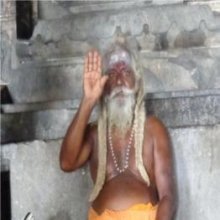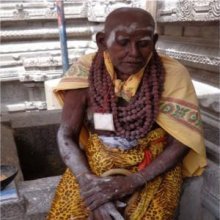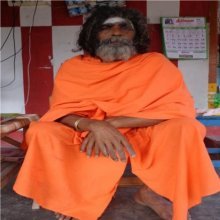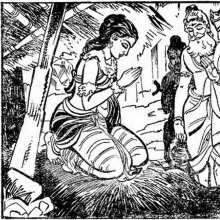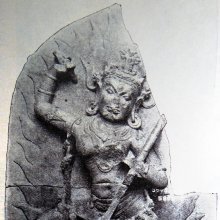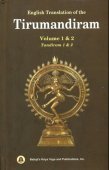Ase, Ashe: 4 definitions
Introduction:
Ase means something in Hinduism, Sanskrit, biology. If you want to know the exact meaning, history, etymology or English translation of this term then check out the descriptions on this page. Add your comment or reference to a book if you want to contribute to this summary article.
Images (photo gallery)
(+3 more images available)
In Hinduism
Vyakarana (Sanskrit grammar)
Source: Wikisource: A dictionary of Sanskrit grammarAse (असे).—Kṛt affix in the sense of the infinitive (तुमर्थे (tumarthe)) in Vedic Literature,e.g-जीवसे (jīvase); cf. तुमर्थे सेसेनसे (tumarthe sesenase)o P.III.4.9

Vyakarana (व्याकरण, vyākaraṇa) refers to Sanskrit grammar and represents one of the six additional sciences (vedanga) to be studied along with the Vedas. Vyakarana concerns itself with the rules of Sanskrit grammar and linguistic analysis in order to establish the correct context of words and sentences.
Biology (plants and animals)
Source: Google Books: CRC World Dictionary (Regional names)Ase in Yoruba is the name of a plant defined with Iodes africana in various botanical sources. This page contains potential references in Ayurveda, modern medicine, and other folk traditions or local practices.
Example references for further research on medicinal uses or toxicity (see latin names for full list):
· Flora of Tropical Africa (1868)
If you are looking for specific details regarding Ase, for example pregnancy safety, diet and recipes, health benefits, chemical composition, extract dosage, side effects, have a look at these references.

This sections includes definitions from the five kingdoms of living things: Animals, Plants, Fungi, Protists and Monera. It will include both the official binomial nomenclature (scientific names usually in Latin) as well as regional spellings and variants.
Languages of India and abroad
Kannada-English dictionary
Source: Alar: Kannada-English corpusAse (ಅಸೆ):—[noun] a flat stone on which spices are ground.
--- OR ---
Ase (ಅಸೆ):—[noun] the plant Argemone mexicana, of Papaveraceae family, Mexican poppy; yellow thistle.
--- OR ---
Ase (ಅಸೆ):—[noun] the front of the head from the top of the forehead to the bottom of the chin, and from ear to ear; the face.
--- OR ---
Āśe (ಆಶೆ):—
1) [noun] a strong desire; yearning; longing.
2) [noun] an expectation for a favourable thing to happen; a hope.
3) [noun] a feeling that what is wanted will happen.
4) [noun] any quarter of the compass; direction.
5) [noun] ಆಶೆಗೆ ಅಂತ್ಯವಿಲ್ಲ, ಪಾಶಕ್ಕೆ ಕಡೆಯಿಲ್ಲ [ashege amtyavilla, pashakke kadeyilla] āśege antyavilla, pāśakke kaḍeyilla avarice is never satisfied; ಆಶೆ ಅತಿ, ಆಯುಷ್ಯ ಮಿತಿ [ashe ati, ayushya miti] āśe ati, āyuṣya miti he hath limitless desires, but the capacity to achieve them is limited; ಅತಿ ಆಶೆ ಗತಿಗೇಡು [ati ashe gatigedu] ati āśe gatigēḍu too much of greediness, is too bad.
--- OR ---
Āśe (ಆಶೆ):—[noun] the seat of a horse driver; a saddle.
--- OR ---
Āse (ಆಸೆ):—
1) [noun] a strong wish or craving; a desire.
2) [noun] an expectation for favourable happening; a feeling that what is wanted will happen.
3) [noun] any of the four major divisions of a compass; a quarter.
4) [noun] a place or a person giving help, protection to another.
5) [noun] a seat for a rider on a horse, bicycle, etc., usu.padded and of leather, and generally saddled in riding; a saddle.
6) [noun] ಆಸೆ ತೋರಿಸು [ase torisu] āse tōrisu to tempt or encourage someone to do something by promising a reward; to hold out a carrot; ಆಸೆಮಾಡು [asemadu] āsemāḍu to wish or long for; to crave; to desire.
Kannada is a Dravidian language (as opposed to the Indo-European language family) mainly spoken in the southwestern region of India.
Nepali dictionary
Source: unoes: Nepali-English DictionaryĀse (आसे):—adj. hopeful; dependent; n. the wives expecting the return of their husbands;
Nepali is the primary language of the Nepalese people counting almost 20 million native speakers. The country of Nepal is situated in the Himalaya mountain range to the north of India.
See also (Relevant definitions)
Starts with (+22): Aseanaya, Asebadaka, Asebadakatana, Asebadika, Asebadiki, Asebaka, Aseburaka, Aseburakatana, Aseburaki, Aseburukatana, Asecaka, Asecana, Asecanaka, Asecanakadarshana, Asecanavant, Asecanavat, Asecani, Asecaniya, Asecisu, Aseddhar.
Query error!
Full-text (+1220): Ashekutin, Bhasma, Bhasmasat, Vaishtuta, Bhasmabhuta, Vibhuti, Homabhasman, Kshara, Yavakshara, Bhasita, Citabhasma, Bhasmikarana, Bhasmavashesha, Tripundra, Samcayana, Sahabhasman, Abhyashe, Raksha, Bhuti, Parghata.
Relevant text
Search found 335 books and stories containing Ase, Aase, Āśe, Āse, Aseet, Ashe, Ashes, The ashes; (plurals include: Ases, Aases, Āśes, Āses, Aseets, Ashes, Asheses, The asheses). You can also click to the full overview containing English textual excerpts. Below are direct links for the most relevant articles:
Effect of short duration caffeine treatment on the jejunum of adult albino rats < [Volume 15 (issue 2), Oct-Dec 1995]
Role of gems in indian medicine < [Volume 10 (issue 3), Jan-Mar 1991]
Trace element analysis of some copper containing herbs < [Volume 16 (issue 4), Apr-Jun 1997]
Sahitya-kaumudi by Baladeva Vidyabhushana (by Gaurapada Dāsa)
Text 10.15 < [Chapter 10 - Ornaments of Meaning]
Text 10.119 < [Chapter 10 - Ornaments of Meaning]
Text 7.32 < [Chapter 7 - Literary Faults]
Shaiva Upanishads (A Critical Study) (by Arpita Chakraborty)
34. Gauṇa Bhasma < [Chapter 2 - Greatness of Bhasma and Dhāraṇa]
8a. Five kinds of Bhasma < [Chapter 2 - Greatness of Bhasma and Dhāraṇa]
12. Mode of Origin of Vibhūti < [Chapter 2 - Greatness of Bhasma and Dhāraṇa]
Devi Bhagavata Purana (by Swami Vijñanananda)
Chapter 11 - On the description of the greatness of the three kinds of Bhaṣmas < [Book 11]
Chapter 12 - On the greatness in holding the Tripuṇḍra and Bhaṣma < [Book 11]
Chapter 10 - On the subject of Gauṇa Bhasma < [Book 11]
Village Folk-tales of Ceylon (Sri Lanka), vol. 1-3 (by Henry Parker)
Story 131 - The Poor Man And The Jewels < [Part III - Stories of the Cultivating Caste]
Story 12 - The Black Storks’ Girl < [Part I - Stories told by the Cultivating Caste and Vaeddas]
Story 9 - Tamarind Tikka < [Part I - Stories told by the Cultivating Caste and Vaeddas]
Rasa Jala Nidhi, vol 3: Metals, Gems and other substances (by Bhudeb Mookerjee)
Part 10 - How to deprive the ashes of iron of the power of being restored to their original condition < [Chapter IV - Metals (4): Lauha (iron)]
Part 3 - Incineration of Lead < [Chapter VII - Metals (7): Sisaka (lead)]
Part 3 - Incineration of tin < [Chapter VI - Metals (6): Vanga (tin)]
Related products
